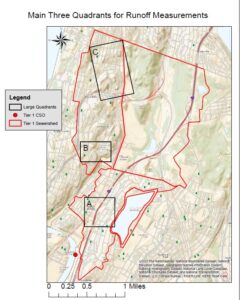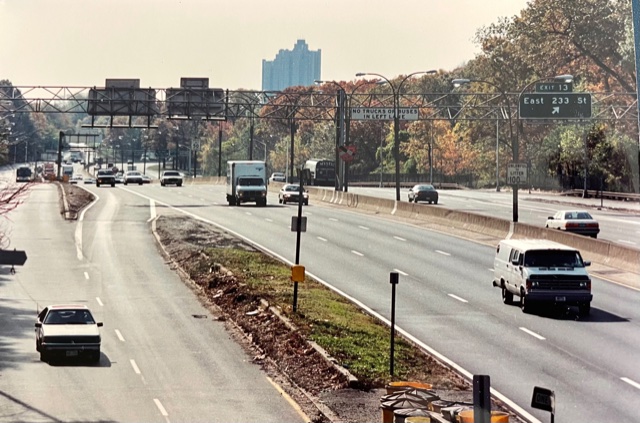The Day Tibbetts Brook Daylighted Itself
September 4th, 2021 Posted in climate changge, eMagazine, Environmental Reviews, Front Page News, Green Infrastructure, Newsletters, Press, Tibbetts Brook Daylighting, Water CommitteeTibbetts Brook Daylighted Itself
The Bronx Council for Environmental Quality call for funding and construction of the Daylighting of Tibbetts Brook Project. While the Daylighting project is being proposed as part of the City’s Combined Sewer Overflow mitigation program, the events of Wednesday, September 1st, indicate that protecting essential infrastructure saves lives and immediately lessens the impact of climate change. We don’t have time to wait.
• BCEQ is calling for the immediate implementation of the project in the ten-year budget.
Robert Fanuzzi, Ph.D., President of BCEQ, stated, “Decades of overbuilding and disinvestment in the Bronx have made the Major Deegan Expressway an international symbol of urban failure to meet the planning changes demanded by climate change. These changes should not be conditioned on the next weather forecast but should have happened yesterday. BCEQ calls for a green floodplain to absorb stormwater; low impact development to manage runoff; and for 30 years, the Daylighting of Tibbett’s Brook to redirect overflow water from Van Cortlandt Lake. How much longer  do we have to wait before the city adopts the natural solutions that can prevent further calamity?”
do we have to wait before the city adopts the natural solutions that can prevent further calamity?”
September 1, 2021’s Tropical Storm “Ida” Remnant was a massive event in New York City that caused tremendous harm to Van Cortlandt Park Lake. The rain overflooded the Lake’s edge, clogged and supercharged the overflow sewer (or weir), and otherwise flooded a large swarth of the lower part of the park, which remains closed days later. In turn, as water sought the lowest point, it routed along the Old Putnam Rail Trail — which is estimated to have flooded as far as West 225th Street. The water overflowed the wall of the Major Deegan, halting car and trucks in place, and closing I-87 thereby disrupting the traffic and lives of Bronxites for days. Van Cortlandt Park is surrounded by four federal highways that discharge stormwater runoff from miles of unmitigated impervious surfaces, to flow directly into the overflowing Lake – a violation of the Clean Water Act. The surrounding upland neighborhoods of Van Cortlandt Village to the East, and Manhattan College to the West, also drain to the lowest point — the Major Deegan. This watershed’s topography is a bathtub-like drainage system, that is not maintained, cleaned, or adequate for the changing climate.
Van Cortlandt Park is surrounded by four federal highways that discharge stormwater runoff from miles of unmitigated impervious surfaces, to flow directly into the overflowing Lake – a violation of the Clean Water Act. The surrounding upland neighborhoods of Van Cortlandt Village to the East, and Manhattan College to the West, also drain to the lowest point — the Major Deegan. This watershed’s topography is a bathtub-like drainage system, that is not maintained, cleaned, or adequate for the changing climate.
• BCEQ calls upon the city to increase funding in all agencies required to maintain the streets and catch basins that were in the flooded areas, and put that report online in plain wording.
Since the last century, BCEQ has been begging the city to change the design guidelines of 2 inches of rain in 24 hours – which is 90% of the storms, but only 10% of the amount of rain. The engineers are aware that the remaining 10% are the “big and wild” storms that equal 90% of the rain amount. “To those who blamed bad forecasting, meteorology is not the problem, risking our lives by not taking climate change seriously is,” stated Karen Argenti, BCEQ Board member. “Continuing to building on every open space, including parkland, caused supercharged and undersized sewer systems, and highway catch basins filled with water that flowed toward the lake unmitigated, is a set up.”
• BCEQ calls on the city to stop all building and encourage and incentivize developers to adopt more stringent design guidelines at a minimum.
As the US Army Corps of Engineers have adopted, green infrastructure will help us weather another storm by engineering with nature.  Here’s the science:
Here’s the science:
“Nature runs an economy; pipes cannot. Rains falls. Streambanks spill over. Soils and plant cover put water to work capturing carbon. Sewer-lines short-circuit this hydrogeology. Brooks and streams follow the lay-of-the-land, building ecosystem services into developing soil pores and capillaries. From these, Nature’s multi-fold networks weave rainfall into roots & shoots, branches and leaves. These together fold the energy of sunlight into life. Were we to learn to build aquifers everywhere, under roadways, parking lots, city-sidewalks, – immense storms and potential flood damage could be turned into a simple resource, a water supply, scaled to power the restoration of living landscapes of the Bronx.” Stated Paul Mankiewicz, Ph.D., Director of the Gaia Institute, Chief Scientist for Leaf Island, and BCEQ Vice President.
The photograph above is looking south along the ten lanes of the Major Deegan Expressway for 4000 feet. Two of those lanes can be sacrificed to capture the water running off from these ten lanes of impervious surface. There are inexpensive ways to manage runoff without harming the oldest forested landscape in NYC. We participate with NYS DOT along the I-684 along side the Kensico Reservoir — the major source of drinking water for the City of New York. We designed an array of terracing multiple infiltration galleries such that there would be zero discharge –no runoff, to the drinking water supply. Here is the math
NB Background files:
- Here are photographs of flooding. Tibbetts Brook Daylighted Itself 9.4.21
- 2015 report to NYC DEP Rivers, Hill, Valley, Park & Heights CB 8 January 2015 short revised 091116.
- Three Quadrants for Runoff Measurements designed by Phoebe Mankiewicz, AmeriCorps Intern now Yale School of the Environment at the Center for Ecology and Architecture. 3LargeMeasureingQuadrants
- Our recent comments to the Planning Commission on Coastal Zoning here.
- News stories about Tibbetts here
Related Posts:







Sorry, comments for this entry are closed at this time.